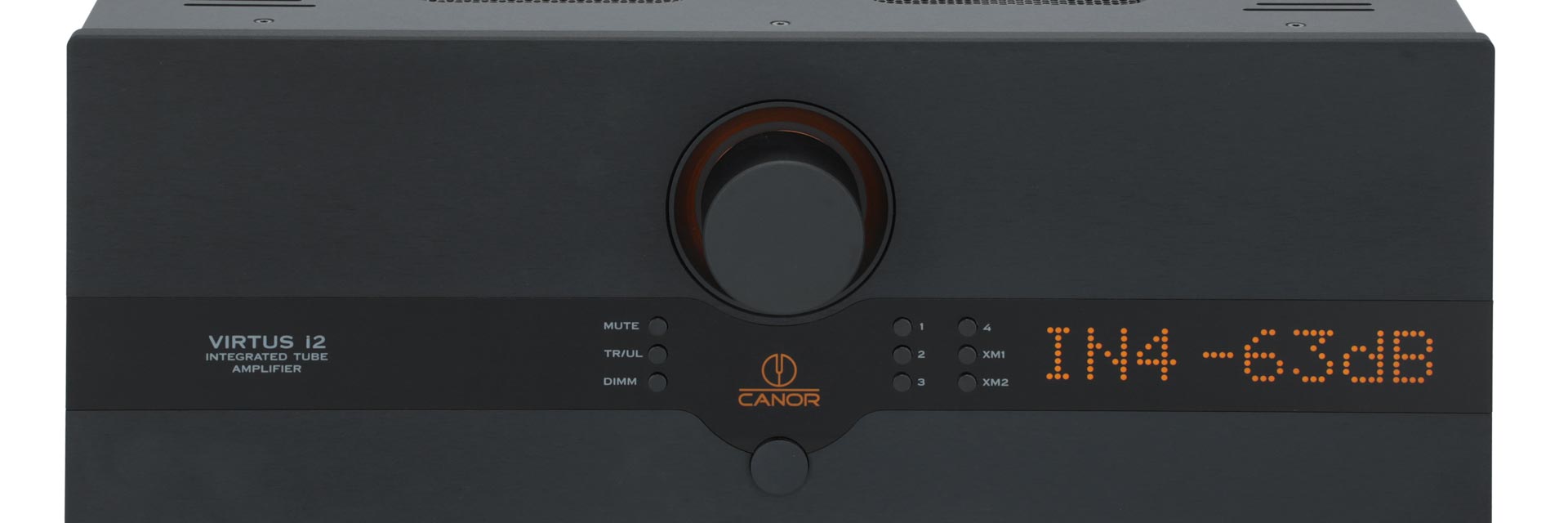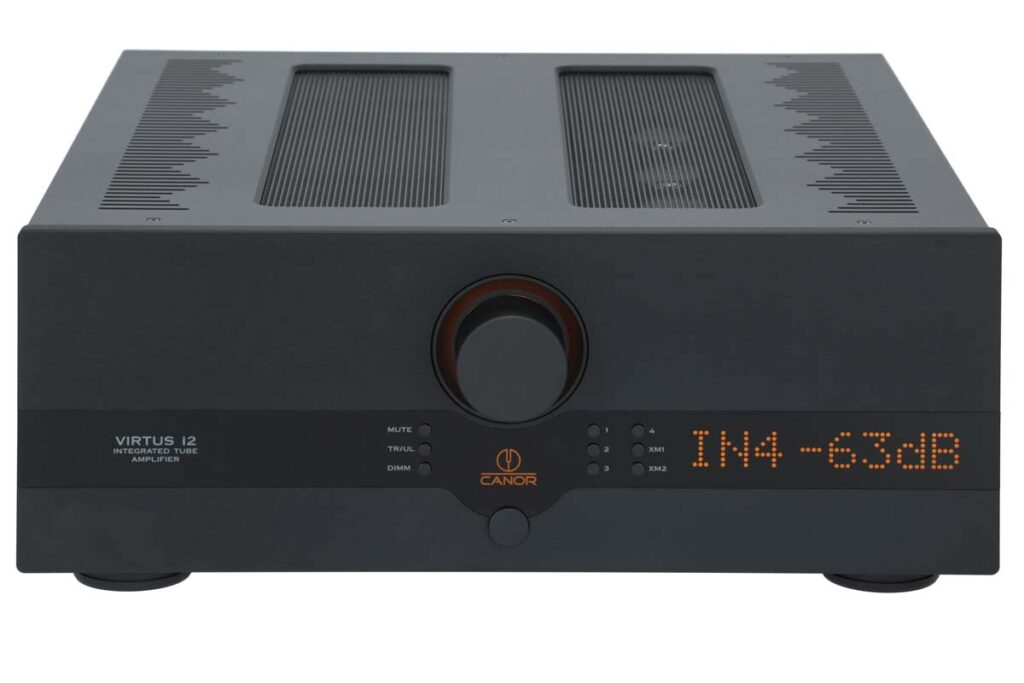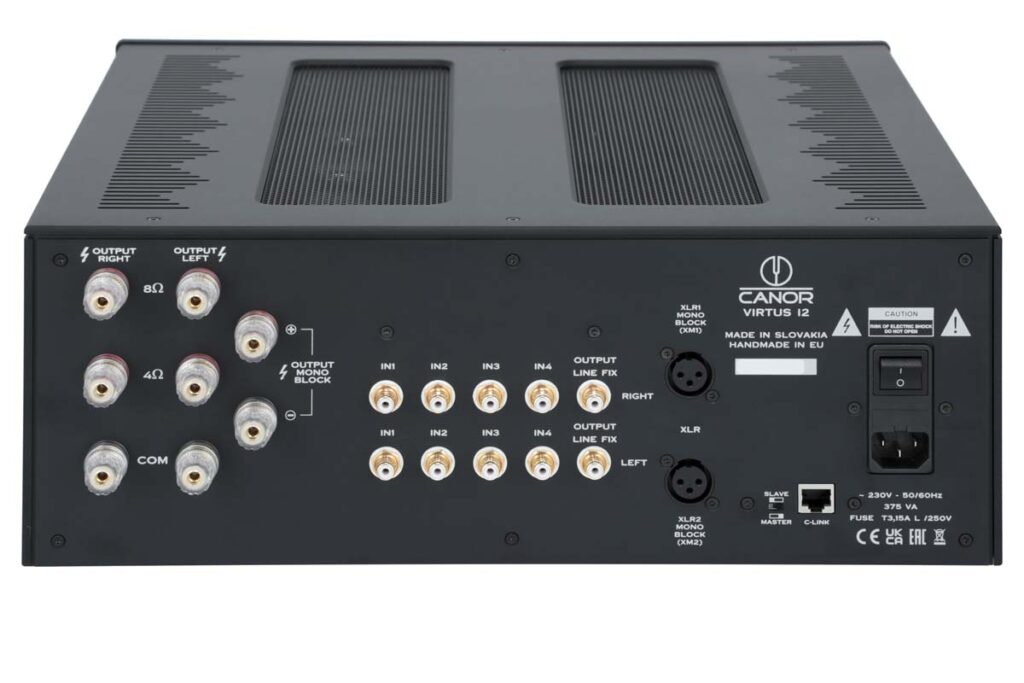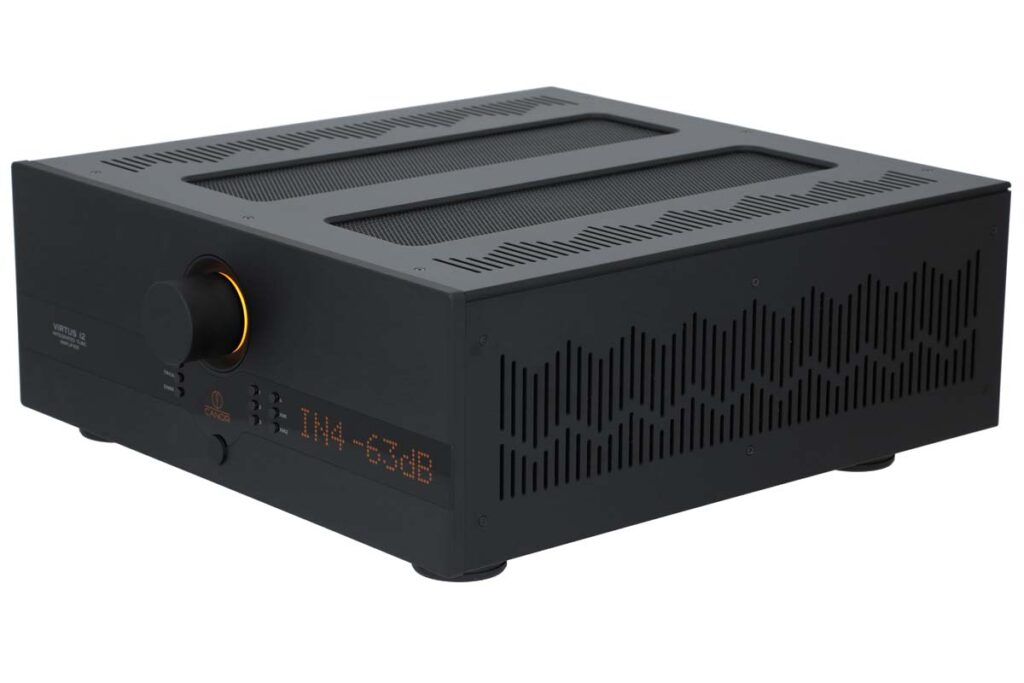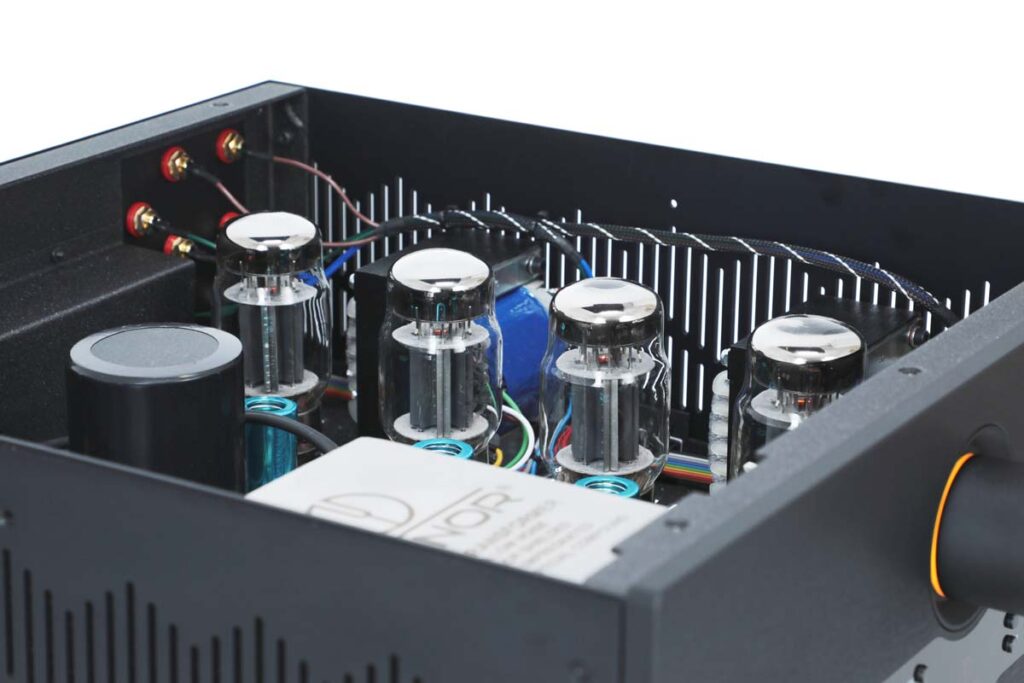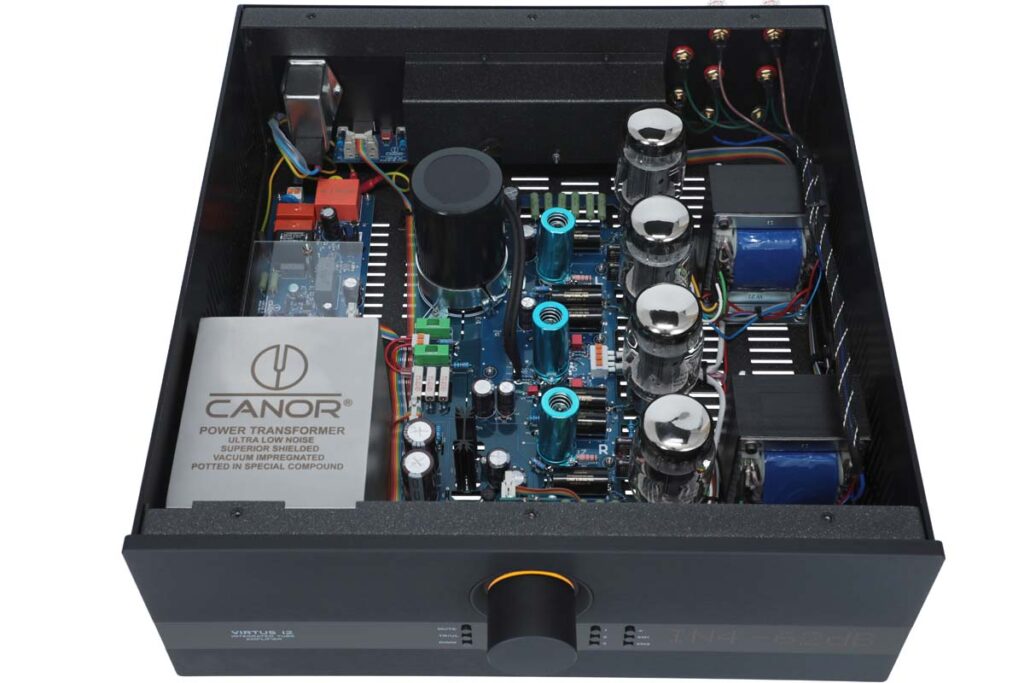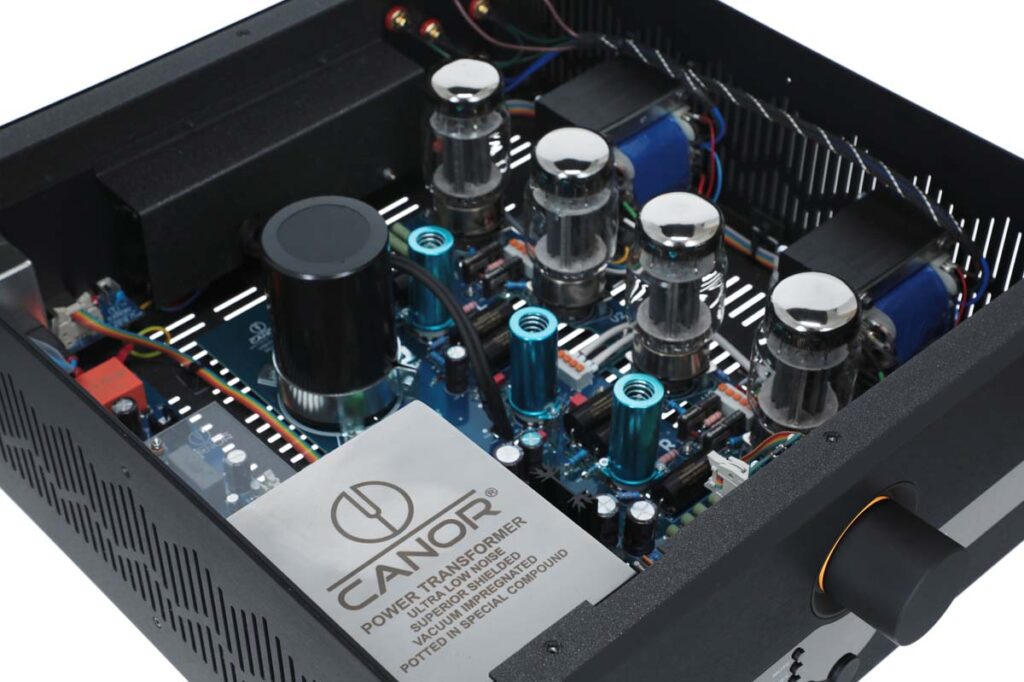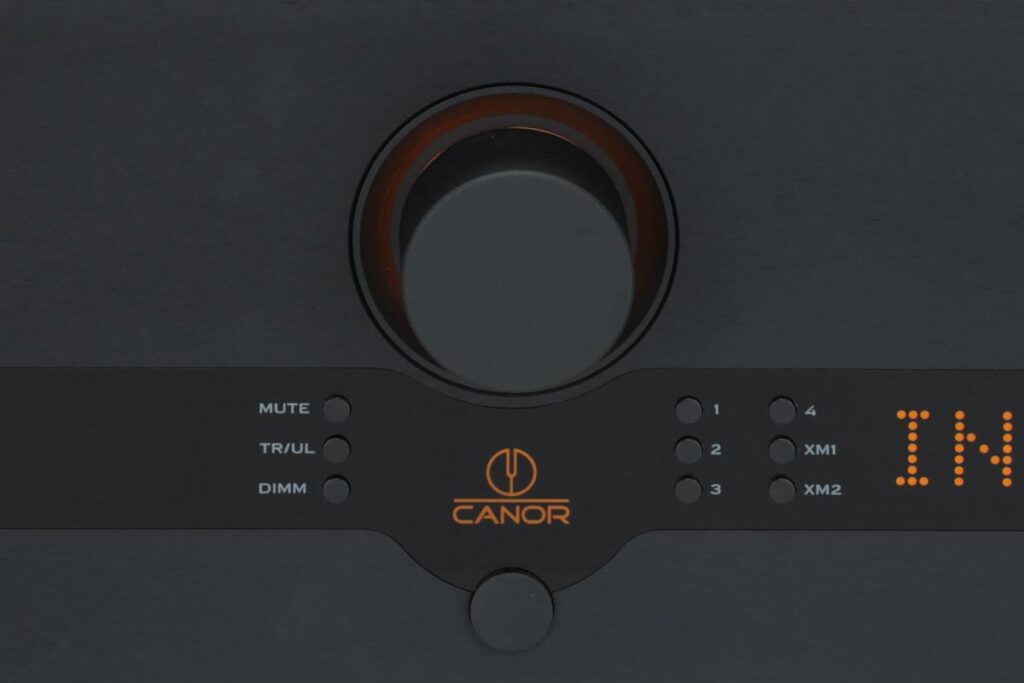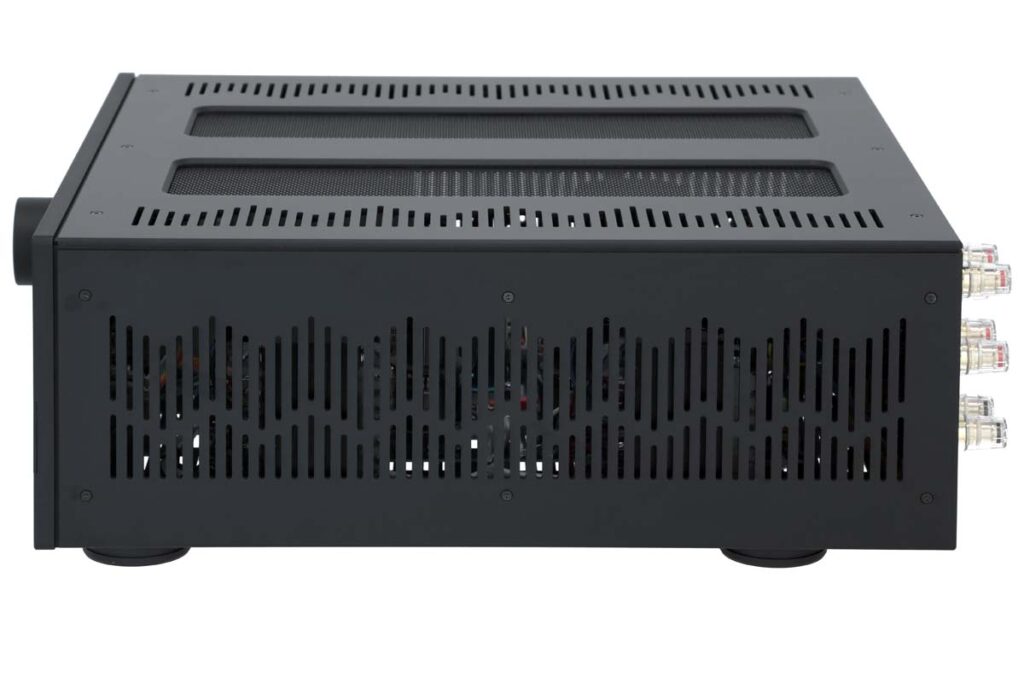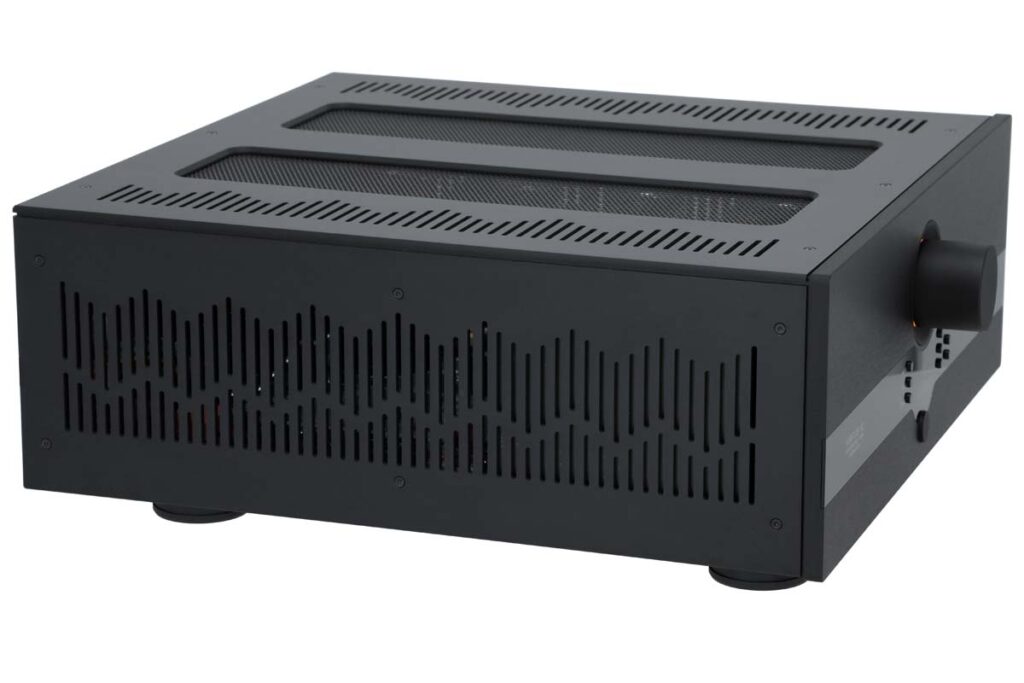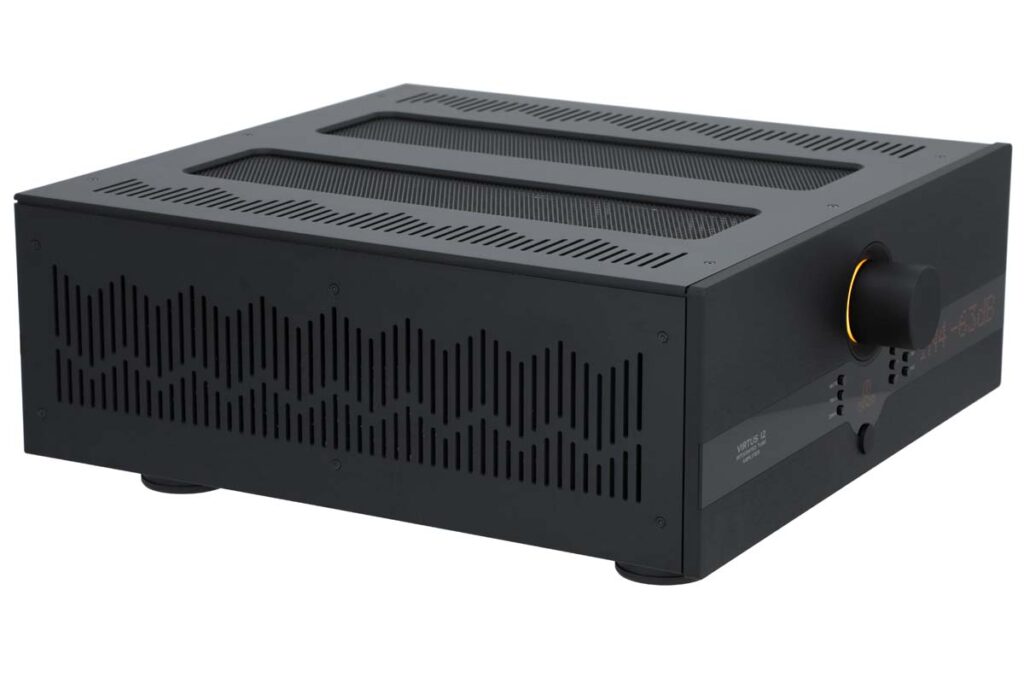No, this integrated amplifier is not intended for music lovers who want to own a tube amplifier primarily for visual reasons.
You won’t get that softly glowing light-organ effect here that will amaze the unwary neighbor. The Slovakian company Canor relies on an enclosed housing principle for its devices – the tubes are hidden inside the device, and only the imposing casework with 10/10-haptics can impress the neighbors. Inside is a quartet of KT88 for a stable 2 x 40 watts in ultralinear mode or 2 x 20 watts in triode mode. Canor’s tube devices are anything but tame little boxes that you just casually slip into the rack – and certainly not the new top-of-the-range device. It’s not just that you don’t simply lift the 28 kilogram Canor Virtus I2 out of the sturdy cardboard box with a flick of the wrist; there are also a few installation modalities to consider.
The Virtus I2 needs space, and a lot of it, so that the air in the room can circulate around it, because the heat radiation is enormous – or to put it another way: The thing gets damn hot. So hot, in fact, that I strongly recommend you position it on the top rack level. During my test phase, I placed the Virtus on the lowest level of my large Finite Elemente rack, and despite a distance of 15 centimeters from the level above, after two hours of operation it had reached such a temperature that I could have fried eggs on it. Of course, listeners experienced with tube amplifiers will just shrug at this, as well as at the power consumption of a whopping 150 watts in idle. And so the Virtus I2 is also one of those tube amplifiers that can handle most standard loudspeakers quite easily and does not require a special high-efficiency speaker. Neither the 83 decibels of the Lyngdorf Cue-100 I was reviewing nor the 89 decibels of my Gamut Phi 7 posed any serious challenge. Even when temporarily switching to triode mode with only half the output power, the Virtus I2 drove both pairs of speakers without any noticeable loss of power.
The detail in the big picture
Before I let Uwe Kuphal, Canor’s German sales expert, tell me about the technological skills of the new development, let’s listen to the I2 for the first time: Let’s start with the audiophile litmus test “female vocals”, a musical category that I usually like to steer clear of, unless Josefine Cronholm’s Wild Garden is spinning in the CD player. The low strings of the double bass vibrate completely freely as the only accompaniment to Cronholm’s clearly articulated alto, before piano, percussion and trumpet join in a complex, interlaced arrangement that can be heard down to the smallest details. The trumpeter’s blowing noises and Cronholm’s breaths can be heard more than clearly, but this should by no means be misunderstood as a weird audiophile pointing, because Canor’s tube amplification makes it wonderfully clear that the breathing noises are part of the arrangement or the individual expression of the artists. The Virtus’ amalgamation of voice and trumpet also reveals an incredible nonchalance.
No, there is no tinsel or show effects to be found here, nor is there the typical tube “crown glass-window sound”, as a colleague once so aptly described it a few years ago, but instead there is an unbelievably relaxed presentation which, despite a holistic sound, always surprises with new small, fascinating details. This strikes me all the more here, as I’m currently going through a phase in which I’m listening to all kinds of jazz recordings in which Jack DeJohnette is involved. His drumming inspires me time and time again with its rhythmic sophistication, which he also knows how to put in the right light with different tonal shades. Again and again, one perceives subtle details within a self-contained sound image, without these being garishly displayed by the amplifier. Or as one would have put it in the aesthetics of the 18th century: great art can be recognized by the fact that its artistic character is not directly perceived. It seems as if Canor’s engineers had studied Sulzer’s Theory of Fine Arts or Kant’s Critique of Judgment before developing their new reference device.
Vorsprung durch Technik
Now it’s time to call the sales department to clarify some of the technical details that have contributed to this impressive performance. Canor has developed its own vacuum tube measuring system to ensure reliable operation of all components that work with tubes. This was necessary because the in-house quality standard could often not be achieved with the previously available measuring systems. The proprietary system, called “Aladdin”, makes it possible to store all measured tube parameters in a database and to select tubes according to various filters for precise measurement. This allows the technicians on site to make a targeted selection from the existing tube pool – the manual “tuberolling” popular with some tube enthusiasts is less effective or even counterproductive here. In addition to tube matching, Canor devotes particular attention to PCB assembly. Due to the high impedances of tube circuits and the sonic effects of the tiniest parasitic capacitances, Canor places particular emphasis on the specially developed CMT technology in the PCB layout. This reduces the deviation from the ideal loss angle and achieves the characteristics of even the most complex point-to-point wiring with consistently high production quality.
The Virtus I2 also offers remarkable flexibility with the option to instantly switch between triode and ultralinear mode, providing the user with different sound characteristics. The Canor offers an auto-bias with cathode feedback for a safe and self-regulating operation of the tubes – a modern plug-and-play tube solution that allows even the layman to handle tube technology with confidence. Canor likes to emphasize the perfect channel separation, which is achieved by a relay volume control with individual blocks for each channel. This controller enables precise gain control in steps of one decibel and can attenuate the signal by up to 63 decibels. What is particularly remarkable here is that more or less all production steps are carried out on site; outsourcing and purchases from suppliers are virtually unknown at Canor. Whether housing or circuit board, whether anodizing or wiring, the in-house principle always applies here.
Pure tube power
But after all the technical details, let’s get back to the real thing, the music. Let’s find out whether the tube power of the Virtus is only made for delicate small jazz ensembles or whether it also has the brawn to make electronic fare sing. All the sonically difficult trip-hop and downbeat records that I have rediscovered recently, be it Massive Attack, Chemical Brothers or the brilliant trip-hop ladies Nicolette and Erykah Badu, they all sound completely detached and free of strain. The basses are deep and stable in the imaginary space, and there is no unpleasant hissing in the highs with hi-hats and sibilants. I find myself listening to almost the entire Nicolette and Badu discography in one go, not least because the wonderful and so idiosyncratic voices are unadulterated and almost seductively in the foreground of the action, while deep, powerful breakbeats flood the room. Yes, this tube amp is a real all-purpose weapon.
With its transparent yet warm organic sound profile and the impressive engineering behind it, the Canor Virtus I2 is not only a technical masterpiece, but also a sonic adventure for audiophiles as well as for more adventurous sound enthusiasts. Considering the fact that we are looking at a device that is almost 100 percent manufactured in-house in Europe, a listening appointment at a friendly specialist dealer is a must. So what are you waiting for?
Accompanying Equipment
Turntables: Thorens TD 126 MK III, Technics SL-1210 MK2 | Tonearm: Koshin GST 801 | Cartridges: Sumiko Blackbird, Ortofon Concord Century | Phono preamplifier: Innovative Audio Ultimate 2b, Thel Phono M | CD player: Naim CD 5i | Streamer: Naim CD5XS | Integrated amplifier: Naim SuperNait | Loudspeaker: Gamut Phi 7 | Headphones: Beyerdynamic DT 1770 Pro | Accessories: Wireworld, Sommer, Creaktiv
Integrated amplifier Canor Virtus I2
Concept: hybrid tube amplifier | Output power (4/8 Ω): 2 x 20 W (triode), 2 x 40 W (ultralinear) | Input sensitivity: 500 mV | Frequency response deviation @5 W (10 Hz to 50 kHz): ±0.5 dB | Input impedance: 30 kΩ | Inputs: 4 x RCA, 2 x XLR (XLR are only active in monoblock circuit) | Outputs: 1 x RCA line-out (line fix) | Distortion factor (1 kHz, 5 W): < 0.05 % | Signal-to-noise ratio: > 95 dB | Tubes used: 4 x KT88/1 x 12AX7/2 x 12AT7 | Finishes: Silver, black | Dimensions (W/H/D): 44/17/49 cm | Weight: 26 kg | Warranty period: 2 years | Price: around €9000
IDC Klaassen
Am Brambusch 22
44536 Lünen
Phone +49 231 9860285
info@canor-audio.de

